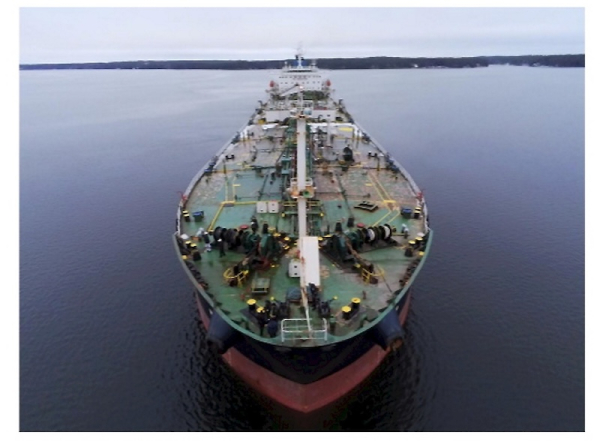Black box offline during cable damage by Russian tanker Eagle S

Screenshot from public police pre-trial investigation material related to the Eagle S tanker court case, featuring a photograph of the vessel taken by the Finnish Border Guard (15 January 2025). Photo: Lehtikuva
- Previous Article Tax relief for high earners, higher deductions for low-income workers
- Next Article Chamber calls for study on points-based immigration system
The voyage data recorder (VDR), or “black box”, of the Russian-flagged oil tanker Eagle S was not functioning during the critical period in which the vessel damaged several undersea cables in the Gulf of Finland.
According to materials from the National Bureau of Investigation (KRP), made public as part of an ongoing criminal trial, the data recorder failed to capture the moment when the vessel’s anchor severed the Estlink 2 electricity cable on 25 December 2024.
Investigators found that the VDR had only begun recording data at 12:59 that day. By that time, the Eagle S had already entered Finland’s exclusive economic zone at 12:23 and crossed over Estlink 2, where the cable was damaged.
KRP officials seized the VDR and conducted technical examinations, including efforts to recover overwritten or deleted data. No usable recordings were found between 18 December and 12:59 on 25 December, a period during which the vessel had mostly remained in Russian territorial waters.
The absence of data raised immediate concerns. Investigators considered both equipment failure and intentional interference. The recorder stores navigation details and bridge communications, which are crucial for incident analysis.
KRP found no signs of tampering. A technical explanation emerged during forensic analysis: the VDR system relied on a GPS time signal, which had been lost intermittently during the voyage.
According to police findings, the GPS receiver onboard had reverted to an incorrect time, sometimes displaying the year 2005, when it failed to acquire a satellite signal. As a result, the recorder deleted existing files to manage disk space. Investigators described the GPS unit as outdated, dating back to the early 2000s.
The captain of Eagle S, Davit Vadatchkoria, told investigators the ship had lost its GPS signal approximately an hour after entering Russian waters. Signal reception remained unstable until it resumed at 12:59 on Christmas Day. At that point, the VDR resumed normal recording, including bridge communications.
At 13:05, just minutes after the system reactivated, the ship’s second mate informed the captain of low engine revolutions. The fifth and final cable break occurred later that evening at 18:43. The Finnish Border Guard subsequently ordered the ship to raise its anchor.
The Helsinki District Court is now handling criminal charges against the captain and two officers. Prosecutors allege serious criminal damage and are seeking unconditional prison sentences of at least 2.5 years.
The Eagle S had been en route between Russian ports at the time, first anchoring in St Petersburg on 21 December, then departing from Ust-Luga with a fuel cargo on 24 December.
The damage to subsea infrastructure has been a
Source: www.helsinkitimes.fi
